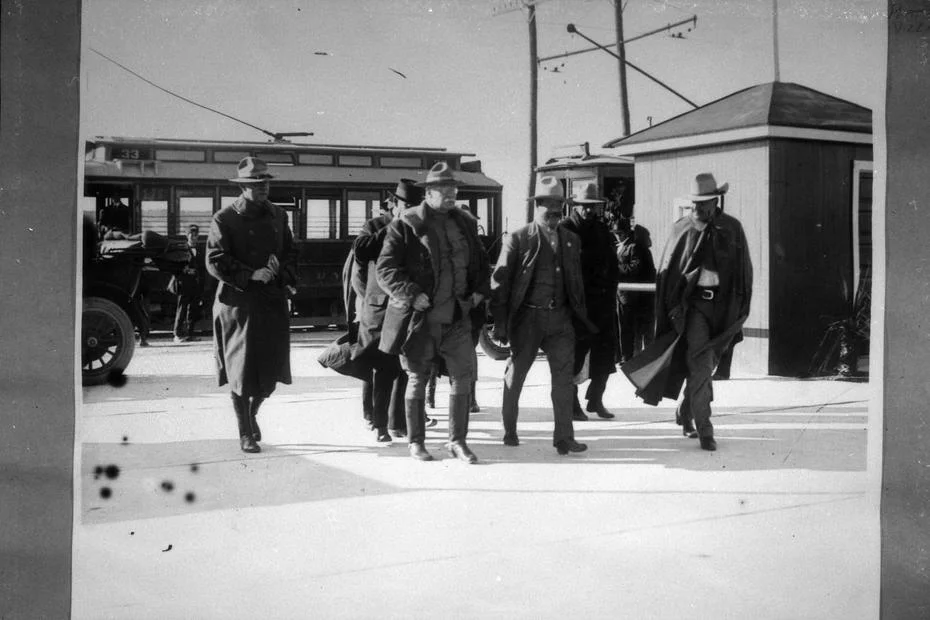In July 1915, Villa found himself in dire straits. His army had been defeated at Celaya and Leon, his control over northern Mexico had shrunk to Chihuahua and parts of Sonora.
Major General Hugh Lenox Scott and Pancho Villa in El Paso
Until then Villa had always refrained from touching American property in order to maintain good relations with the U.S. However, as his fortunes declined rapidly and since northern Mexico had endured half a decade of looting, confiscations, “special” taxations, and destruction, there was little Mexican property left to confiscate. Villa announced in the beginning of August that he intended to levy a special “tax” on American mining companies. Companies such as ASARCO (American Smelting and Refining Company), the largest smelting operation in Mexico, immediately raised alarm in Washington. Many mines had already ceased operations and pulled out their employees because of the chaotic environment in Northern Mexico as Carranza’s armies pushed Villa ever further north. Villa needed these businesses to operate in order to generate income from export duties for Chihuahua. He threatened companies that did not resume operations with confiscation. He seized several mines in southern Chihuahua and operated them with his own men in July 1915 to make his point. Although these forced operations did not legally constitute confiscation, Villa’s mine operators sent the bullion to their broke chieftain rather than the legitimate owners of the mines. The New York Times reported on August 2 that Villa had confiscated numerous foreign businesses and expelled “an entire trainload of foreigners.” The Chihuahua merchants had refused to take the worthless Villa currency for payment by customers. It was a desperate and ineffectual attempt to curb inflation and the devaluation of his currency.
When the Army Chief-of-Staff General Hugh Lenox Scott met with Villa in the beginning of August, he made the argument that Villa would forfeit his chances to have his faction recognized as the legitimate power in Mexico if he would not release these businesses. Secretary Lansing instructed Scott to tell Villa “the United States would never recognize Carranza.” While Scott later claimed that he did not relay this statement to Villa, Sommerfeld, who as a confidante of both Villa and Scott was undoubtedly informed, certainly did. Much to the surprise of observers, but not so surprising giving the assurances of the U.S. State Department, Villa acceded to all of Scott’s demands. “In all, there was more than six million dollars [Villa returned to American businesses] for which I had no equivalent to offer to Villa or promises to make, and he gave them up because I asked him; no more and no less.” Scott did offer to allow Villa the exportation of cattle (with questionable ownership) to the U.S. for cash. However, when Secretary Lansing mentioned the proposal to the President, he stopped it. “Do you think it wise to put Villa in the way of getting money just at the moment when he is apparently weakest and on the verge of collapse?” the President questioned, clearly showing that he had, by then, already changed his mind. To be fair, the real value of what Villa conceded to Scott was only the value of the production revenue of these mines and the confiscated merchandise in Chihuahua. However, with his fiat money devalued and his area of control shrinking by the day, Villa’s concessions did constitute a major sacrifice on his part. Not surprisingly, Villa’s cession of the mining properties coincided with him not sending any more funds to Felix Sommerfeld and Lazaro De La Garza to pay for the munitions he had under contract in the U.S.
Sommerfeld turned to the Secret War Council to foot the bill... Read the next installment of "the road to Columbus," explaining how German money finances Villa's military supplies. This blog series will trace the events that led to Villa's attack on Columbus, New Mexico on March 9, 1916 in weekly segments. On March 12, I will speak at Columbus for the Centennial Commemoration of the raid and reveal how Villa was made to believe that attacking the United States was a good idea. If you get impatient and do not want to wait for eight months to learn the facts behind Columbus, buy Felix A. Sommerfeld and the Mexican Front in the Great War now.

